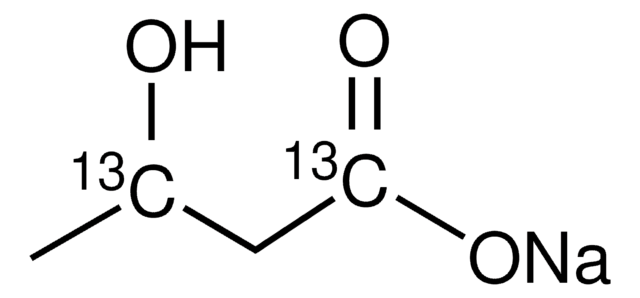Products may be shipped at a different temperature than the recommended long-term storage temperature. If the product quality is sensitive to short-term exposure to conditions other than the recommended long-term storage, it will be shipped on wet or dry-ice. If the product quality is NOT affected by short-term exposure to conditions other than the recommended long-term storage, it will be shipped at ambient temperature. As shipping routes are configured for minimum transit times, shipping at ambient temperature helps control shipping costs for our customers. For more information, please refer to the Storage and Transport Conditions document: https://www.sigmaaldrich.com/deepweb/assets/sigmaaldrich/marketing/global/documents/316/622/storage-transport-conditions-mk.pdf
Wichtige Dokumente
166898
3-Hydroxybuttersäure
95%
Synonym(e):
(±)-3-Hydroxybuttersäure, DL-β-Hydroxybuttersäure
Größe auswählen
Größe auswählen
About This Item
Empfohlene Produkte
Qualitätsniveau
Assay
95%
Form
liquid
Brechungsindex
n20/D 1.443 (lit.)
bp
118-120 °C/2 mmHg (lit.)
Löslichkeit
ethanol: soluble 50 mg/mL, clear
Dichte
1.126 g/mL at 25 °C
1.126 g/mL at 25 °C (lit.)
Funktionelle Gruppe
carboxylic acid
hydroxyl
Lagertemp.
2-8°C
SMILES String
CC(O)CC(O)=O
CC(O)CC(O)=O
InChI
1S/C4H8O3/c1-3(5)2-4(6)7/h3,5H,2H2,1H3,(H,6,7)
InChIKey
WHBMMWSBFZVSSR-UHFFFAOYSA-N
WHBMMWSBFZVSSR-UHFFFAOYSA-N
Suchen Sie nach ähnlichen Produkten? Aufrufen Leitfaden zum Produktvergleich
Verwandte Kategorien
Allgemeine Beschreibung
Anwendung
Anwendung
Signalwort
Danger
H-Sätze
Gefahreneinstufungen
Eye Dam. 1 - Skin Corr. 1B
Lagerklassenschlüssel
8A - Combustible corrosive hazardous materials
WGK
WGK 3
Flammpunkt (°F)
233.6 °F - closed cup
Flammpunkt (°C)
112 °C - closed cup
Persönliche Schutzausrüstung
Eyeshields, Gloves, type ABEK (EN14387) respirator filter
Hier finden Sie alle aktuellen Versionen:
Besitzen Sie dieses Produkt bereits?
In der Dokumentenbibliothek finden Sie die Dokumentation zu den Produkten, die Sie kürzlich erworben haben.
Kunden haben sich ebenfalls angesehen
Chromatograms
suitable for GC-
How is shipping temperature determined? And how is it related to the product storage temperature?
1 Antwort-
Hilfreich?
-
-
How can I determine the shelf life / expiration / retest date of this product?
1 Antwort-
If this product has an expiration or retest date, it will be shown on the Certificate of Analysis (COA, CofA). If there is no retest or expiration date listed on the product's COA, we do not have suitable stability data to determine a shelf life. For these products, the only date on the COA will be the release date; a retest, expiration, or use-by-date will not be displayed.
For all products, we recommend handling per defined conditions as printed in our product literature and website product descriptions. We recommend that products should be routinely inspected by customers to ensure they perform as expected.
For products without retest or expiration dates, our standard warranty of 1 year from the date of shipment is applicable.
For more information, please refer to the Product Dating Information document: https://www.sigmaaldrich.com/deepweb/assets/sigmaaldrich/marketing/global/documents/449/386/product-dating-information-mk.pdfHilfreich?
-
-
3-ヒドロキシ酪酸は液体とのことですが,濃度はどれくらいになるのでしょうか?
1 Antwort-
This product is a neat or pure liquid and has not been diluted. The density of this material is 1.126 g/mL at 25 °C with a molecular weight of 104.1 daltons. The minimum purity of this product is 95%. The molarity of this product may range from 10.26 M at 95% to 10.8 M at 100%. Please refer to product Certificate of Analysis for the lot specific purity.
Hilfreich?
-
-
What's the solubility in paraffin oil?
1 Antwort-
Unfortunately, solubility information for Product 166898 in paraffin oil is unavailable. However, it is soluble in ethanol at 50 mg/mL.
Hilfreich?
-
Aktive Filter
Unser Team von Wissenschaftlern verfügt über Erfahrung in allen Forschungsbereichen einschließlich Life Science, Materialwissenschaften, chemischer Synthese, Chromatographie, Analytik und vielen mehr..
Setzen Sie sich mit dem technischen Dienst in Verbindung.










![Poly-[(R)-3-hydroxybuttersäure] natural origin](/deepweb/assets/sigmaaldrich/product/structures/129/476/7d1c924b-f644-4889-a2d6-d7a923ce382c/640/7d1c924b-f644-4889-a2d6-d7a923ce382c.png)


